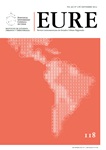The Metro extension in MadridÍ€™s periphery (1999-2011)
DOI:
https://doi.org/10.4067/S0250-71612013000300006Keywords:
transportation models, mobility, metropolitan areasAbstract
The growth of population and jobs in the metropolis of Madrid means an increase in this city 's mobility and complexity. This paper analyzes how this situation affects the planning of public transports by the Government of Madrid, whose main investment effort since 1999 has focused on the expansion of the subway network to the municipalities surrounding the capital. The analysis of the efficiency of these extensions provides the following results: i) the lower cost of investment in the light rail has made it possible to reduce the financial problems of the governments of Madrid, and ii) the demand for the new transport services increases during the early years, although it descends later. These findings suggest the complexity of the economic and political decisions linked to these enlargements, which have been adapted to the Madrid's polycentric and scattered development.
ÍDownloads
Published
How to Cite
Issue
Section
License
Copyright (c) 2013 Revista EURE - Revista de Estudios Urbano Regionales

This work is licensed under a Creative Commons Attribution 4.0 International License.
Al momento de aceptar la publicación de sus artículos, los autores deberán formalizar la cesión de derechos de autor a EURE, según las condiciones establecidas por la Revista.
Ésta establece que el autor autoriza a EURE de manera gratuita, exclusiva e ilimitada a reproducir, editar, publicar, distribuir, publicitar, comercializar y traducir el artículo, a cualquier soporte conocido o por conocer y desarrollar.
Del mismo modo, los autores aseguran que el artículo propuesto es original, no publicado y no propuesto para tal fin a otro medio de difusión.


